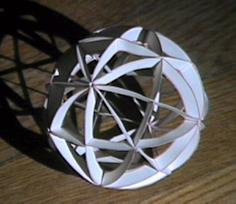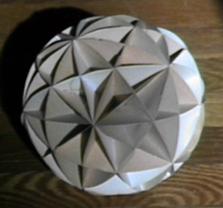Symmetry Planes
The symmetry planes of an object are imaginary mirrors in which it can be reflected while appearing unchanged. A chiral polyhedron such as the snub cube or snub dodecahedron has all the axes of symmetry of its symmetry group, but no planes of symmetry. A reflexible polyhedron has at least one plane of symmetry. If there are more than one symmetry plane, they meet at its center.
The Nine Planes of Symmetry of the Cube and/or Octahedron
 The
paper model at right illustrates the nine
planes of symmetry of the cube and/or octahedron.
It contains two different types of symmetry planes:
The
paper model at right illustrates the nine
planes of symmetry of the cube and/or octahedron.
It contains two different types of symmetry planes:
- three of the planes are orthogonal to the three 4-fold symmetry axes; each such plane is parallel to, and halfway between, two opposite faces of the cube; these three planes are mutually orthogonal.
- six of the planes are orthogonal to the 2-fold axes; each such plane contains two opposite edges of the cube (and so is an orthogonal bisector to two opposite edges of the octahedron). Two of these planes meet each other at either 90 degrees (if they share a 4-fold axis) or 60 degrees (if they share a 3-fold axis).
A plane from the first set and a plane from the second set will meet each other at either 45 degrees (if they share a 4-fold axis) or 90 degrees (if they share a 2-fold axis).
Together the planes divide the surface of a sphere into 48 triangular regions called Mobius triangles. Each is a 45-60-90 spherical triangle with a 4-fold, a 3-fold, and a 2-fold axis at the respective corners. Eight such triangles cover one square face of the cube; six such triangles cover one triangular face of the octahedron; four cover one rhombus of the rhombic dodecahedron.
The Fifteen Planes of Symmetry of the Icosahedron and/or Dodecahedron
 The
paper model at right illustrates the fifteen
planes of symmetry of the icosahedron
and/or dodecahedron (which being mutually
dual, share their symmetry group and symmetry planes). There is only
one type of plane in this case. Each plane contains two opposite edges
of the icosahedron and two opposite edges of the dodecahedron. They can
be colored as five sets
of three mutually orthogonal planes. Incidentally, the paper model
illustrated was made from brightly colored, inexpensive construction paper
(three planes each of red, blue, green, yellow, and white) but has faded
to dull shades of grey over 15 years.
The
paper model at right illustrates the fifteen
planes of symmetry of the icosahedron
and/or dodecahedron (which being mutually
dual, share their symmetry group and symmetry planes). There is only
one type of plane in this case. Each plane contains two opposite edges
of the icosahedron and two opposite edges of the dodecahedron. They can
be colored as five sets
of three mutually orthogonal planes. Incidentally, the paper model
illustrated was made from brightly colored, inexpensive construction paper
(three planes each of red, blue, green, yellow, and white) but has faded
to dull shades of grey over 15 years.
The fifteen planes divide the sphere into 120 Mobius triangles. Each is a 36-60-90 spherical triangle with a 5-fold, a 3-fold, and a 2-fold axis at the respective corners. Ten such triangles cover one pentagon of the dodecahedron, six cover one triangle of the icosahedron, and four cover one rhombus of the rhombic triacontahedron.
If we place a cube inside a dodecahedron or an octahedron inside a dodecahedron, we can see how the symmetry planes of the cube/octahedron relate to the symmetry axes of the dodecahedron. The three mutually orthogonal planes of the cube are one set of the five sets making up the dodecahedron's planes of symmetry.
The Planes of Symmetry of the Tetrahedron
The tetrahedral symmetry group comes in three flavors, according to which planes of symmetry are present. The three cases are best explained with a typical example for each. in each of the following three cases, observe that all seven axes of tetrahedral symmetry are present.
- the tetrahedron itself is an example which has six planes of symmetry. Each plane contains the center of the tetrahedron and one edge (and so bisects the opposite edge). These six planes of symmetry are the same as the second group of planes listed above for the cube and octahedron.
- a chiral object with tetrahedral symmetry has no planes of symmetry. This is analogous to the snub cube and snub dodecahedron cases described above. Interestingly, a snub tetrahedron can be thought of as a three-colored icosahedron---red represents the tetrahedral faces; green the tetrahedral vertices, and blue the pairs of faces which replace the tetrahedron's edges. Other examples are the tetrahedrally stellated icosahedron and the tetrahedrally truncated dodecahedron, which are described on their own page, and this canonical 22-sided solid. The one with the fewest faces is the 12-sided tetartoid.
So far, these two cases are exactly analogous to the octahedral and icosahedral situations. There is also a third case however:
- it is possible to have the axes of symmetry of the tetrahedron with just three planes of symmetry. These three planes of symmetry are the same as the first group of planes listed above for the cube and octahedron---the three mutually orthogonal planes. This is sometimes called pyrite symmetry as it is the symmetry of one form of the mineral pyrite, a not-quite-regular dodecahedron called a pyritohedron. As other examples, consider this cube with a stripe on each face, or this perforated trapezoid-faced variation on the dodecahedron, or these compounds of four cubes and four octahedra. Be sure to observe their three planes of symmetry.
The Planes of Symmetry of a Prism or Antiprism
An n-gonal prism has two kinds of planes of symmetry:
- one plane orthogonal to the n-fold axis, halfway between the two n-gons, and
- n planes each containing a 2-fold axis and the n-fold axis. If n is odd each plane contains one edge (between two adjacent squares) and bisects the opposite square. If n is even, half the planes contain two opposite edges and the other half bisect two opposite squares.
The antiprism leaves out the first plane and has its planes of symmetry half-way between its 2-fold axes.
Exercise: Which of the four symmetry types listed above, if any, does the pentagonal pyramid fall under ?
Answer: None of the above; pyramids have the same n planes of symmetry as the antiprism, but no 2-fold axes of symmetry.